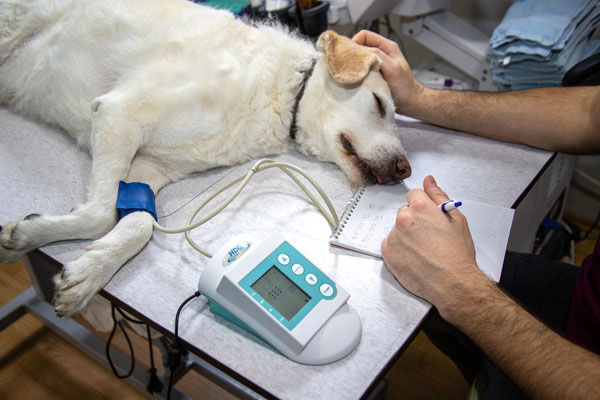Owning a dog comes with a lot of responsibility. You want to make sure you provide the best foods, plenty of fresh water, and the most comfortable bed. But you also need to address your pup’s health. That means a healthy regime of activity, mental stimulation to prevent boredom, and addressing their medical needs. That includes preventive health. One of the biggest checkboxes is spaying or neutering. The surgical procedure is the first your puppy undergoes. And if you didn’t get your dog from a shelter, the financial burden falls on your shoulders. But what’s the cost to spay or neuter a dog? And when you see the price tag, do you know what comes with that cost? If you’re feeling anxious, take a deep breath. We’ve got all of the answers to your questions.
OVH and Castration
Dogs undergo two different sterilization procedures depending on their sex: spay for females or neuter for males. You’ll hear and see the procedures referred to as ovariohysterectomy (OVH) and castration in veterinary terms. They mean the same thing (one set of terms just sounds more complicated).
During a spay, the veterinarian opens the abdominal cavity in order to remove your dog’s uterus and ovaries. Then they suture the abdomen closed again.
In a neuter, the vet makes an incision in the scrotum and removes your dog’s testicles. Occasionally, they’ll remove the scrotum, as well. This depends on your dog’s age and size, and the vet will discuss the possibility with you ahead of time. If not, they suture the scrotum closed.
Both procedures require careful post-operative care. (You guessed it – you’re dog’s going to wear an E-collar)
Sounds easy enough, right? So what’s the cost of a spay or neuter? Well, that’s a little more complicated.

Cost to Spay or Neuter a Dog
When you look at the cost to spay or neuter a dog, you need to consider a few variables. The procedures don’t change, but other things DO:
- The size of your dog
- Your dog’s age
- Pre-existing health conditions
- Where you live
- The location you choose
- Which procedure’s being done
Put all of that information together, and the average cost to spay a dog runs from $35-$600. The average cost to neuter a dog goes between $45-$300.
Big range, right? Each piece of the equation goes into figuring out where your pup might fit.
Spays cost more. Vets need to go into the abdominal cavity. That requires more time, more risk for complications, and more concern for post-op recovery.
The larger your dog, the more medications a vet needs to use. Whether you’re talking sedation, anesthetic, antibiotics, or pain medications. It’s basic math. So a giant breed dog WILL cost more than a tiny breed.
And large metropolitan areas have higher costs than rural country areas. However, if you opt for a low-cost spay or neuter option, you can shave some money off the procedure in your city. (We’ll get to that in a minute) But before you throw in the towel looking at that price tag, let’s look at what goes into the cost to spay or neuter a dog FIRST.
“Please don’t price shop for a spay. An adult, large breed, slightly overweight or obese dog spay is the single most difficult surgery that most veterinarians will do.”
~Pam Nichols, DVM, CCRP, President of American Animal Hospital Association (AAHA)
What Goes Into the Cost to Spay or Neuter a Dog
You made the appointment for your dog to go in for a spay or neuter. You know they’re going to have a surgical procedure. And you know you’re getting a bill. But you may or may not get an itemized estimate explaining what goes into the cost to spay or neuter. You can (and SHOULD) ask the veterinary staff to explain everything and walk you through the terminology. And it’s okay to ask for a tour of the operating room so you can see everything. (If you’re squeamish, please warn them ahead of time)
That’s your precious furry baby going under the knife. You have the right to understand what’s about to happen! And once you understand everything adding up to the final bill, you might feel easier about handing over your credit card. Because it’s A LOT!
Pre-Op
Before your dog reaches the operating room, your vet needs to make sure they’re in tip-top shape. If you’ve undergone a surgical procedure, you know you need a thorough workup first. Your puppy gets the same treatment. This may happen the morning of the spay or neuter, or it could happen a few days before. Each clinic has its own policies.
First, your dog gets a thorough physical examination. From the tip of their nose to the end of their tail, your vet looks at and palpates everything. They want to make sure your dog looks, feels, and sounds healthy. They’ll take a listen to your pup’s heart and lungs with a stethoscope. If ANYTHING seems amiss, they’ll put a hold on the spay or neuter until further testing is done.
Next comes lab work. You MAY have the option to skip this step, especially if you have a puppy. But, honestly, it’s a nice pre-op check. Your dog will receive medications that get processed through the kidney and liver. Making sure those two organs are working? Yeah, it’s a nice check. Many clinics have packages that fold lab work into spaying or neuter costs, so it’s not even an extra.

Surgery Time
Whenever your dog undergoes a surgical procedure, it feels like it takes FOREVER. And it certainly takes a few hours. Why? Well, there are a lot of steps involved. While you’re pacing the floors, waiting for the all-clear phone call, the vet staff perform a coordinated dance.
- Puppies, especially, get some sedation. The injectable medication relaxes them, so they remain calm for the rest of the procedure.
- Your dog gets an IV catheter. This helps the surgical team keep access to an open vein at all times and allows for IV fluid support.
- Injectable anesthetic drugs go through that IV, calmly lulling your dog to sleep.
- A veterinary technician places an endotracheal tube and starts your dog on inhalant anesthesia.
- Anesthetic monitoring devices get hooked up. This includes an EKG, blood pressure cuff, and pulse oximetry (this monitors your dog’s oxygen levels) – at a minimum. A technician watches and records the values throughout the procedure.
- Your dog gets positioned for their procedure. Typically, this is on their backs. They have heating blankets and padding to keep them comfortable.
- The hair around the surgical site gets shaved (hair is FILTHY and an infection risk). Then the skin gets scrubbed with an antiseptic solution.
- Your vet performs the surgery.
- A technician sits with your brave kiddo while they wake up and recover, continuing to monitor them and keep them warm.
Post-Op
Yay! You get to come pick up your dog – usually at the end of the day. The vet staff presents you with your trusty E-collar (which you will NOT decline). You get your discharge instructions, warning you that your dog needs to keep the activity to a minimum for the next two weeks. You may or may not receive antibiotics (it depends on the vet, honestly). And you’ll get pain medications to take home for the first few days or so while your kiddo recovers.
Please, please, please accept the pain medications. I speak to you as a human being who’s undergone an OVH procedure. Having organs removed HURTS! And dogs feel pain the same as we do. Let your pup have their pain meds. Yes, it adds to the cost to spay or neuter a dog, but your furry friend will thank you. (And I thank you – from one creature to another)
Rounding Up the Cost Numbers
If you break down all the parts and pieces involved, you’re getting a bargain. You’re covering the salaries of the individuals participating on the surgical team. You help pay for the equipment involved in the procedure. And all of the medications involved? They’re not delivered free to veterinary clinics. (Though that would be AWESOME!) So when you look at the cost to spay or neuter a dog, you’re getting a lot for your price!
Additions
Now, a few special cases can drive up the cost to spay or neuter a dog. As you go up in age, things get trickier with anesthesia. Your vet may request an EKG to check for cardiac disease, and they WILL want lab work. And, of course, those reproductive organs become more developed. The procedure takes longer. Other situations that add extra fees include:
- Dogs that are pregnant or in heat (add $50-$150)
- Obese dogs (add $10-$30 for EACH medication)
The Low-Cost Alternative for Spays and Neuters
You love your dog, you want to act responsibly, but your budget only stretches so far. Non-profits and government agencies have stepped into the breach by raising money to fund low-cost spay and neuter clinics. As a result, you’ll find a discounted price for the same procedure. The low-cost alternative came about from the need to curb overpopulation problems in the pet world. With the ability to offer a reduced cost to spay or neuter a dog, these veterinarians pitch in for people on strict budgets.
You’ll still have the chance to sit down and talk with the staff performing the procedure. And you should ask to tour the clinic where the surgery takes place. Low-cost spay and neuter clinics often ONLY offer those procedures. They won’t substitute for a regular veterinarian. So make sure you take the time to speak with the vet and get answers to all of your questions. You want a good feeling going into the surgery. After all, they won’t be the same people you know.
“When you go to a low-cost clinic, you should be getting the same level of care you would expect at a full-service clinic. Today, vets and staff at these clinics are highly trained and can do many more spay/neuter surgeries a day than a full-service practice because of the level of efficiency.”
~Nellie Goetz, DVM, Executive Director of Altered Tails
Understanding the Differences with Low-Cost Spay and Neuter Clinics
There’s NOTHING wrong with choosing a low-cost spay and neuter clinic. They popped up for a positive reason, and the money comes from donations and government subsidies. They’re run by licensed staff that undergo the same training your veterinarian went through.
But you WILL find a difference with a low-cost clinic. Which is why the cost to spay or neuter a dog there is so different. Make sure you understand the difference before you make that call.
- You won’t have an option for pre-op lab work, an IV catheter, or anesthetic monitoring
- The vets focus on high-volume operations, so you may not get a lengthy post-op phone call (or any phone call)
- Some low-cost clinics don’t use inhalant anesthesia

Finding a Low-Cost Spay or Neuter Clinic
If you have questions about finding a low-cost clinic, you can always talk to your veterinarian. They should point you in the right direction. Your local animal shelters should know all of the options in the area, too. (Odds are they make use of them to save on their bills) Otherwise, you have plenty of online resources you can rely on to steer you in the right direction:
- Animal League Spay Resources
- ASPCA Low-Cost Spay and Neuter Program
- PetSmart Charities Spay and Neuter Program
Down with Overpopulation
The cost to spay or neuter a dog can feel daunting. Once you start to break the procedure down and look at everything (and everyone) involved, though, things aren’t too horrible. And spaying and neutering do so much good – for your dog and the world, in general. Pet overpopulation results in millions of dogs entering shelters and rescues every year. Dogs left intact develop health concerns and unwanted behaviors. Weighed against those costs, is a spay or neuter really that bad?
Your dog will thank you – once the E-collar comes off.













2 Comments
Hello! Great read. I totally agree that dogs should be neutered, and today animal control came to my house saying so too. They said I must neuter my dog or else I will get fined! What do I do now?
My Milo “dog” was neutered for $120 from Knightdale Animal Resort. Best in town and very reasonable price. They have also explained it to me when is the best time to neuter your fellow.
https://www.knightdalepetresort.com/when-should-i-neuter-my-dog/